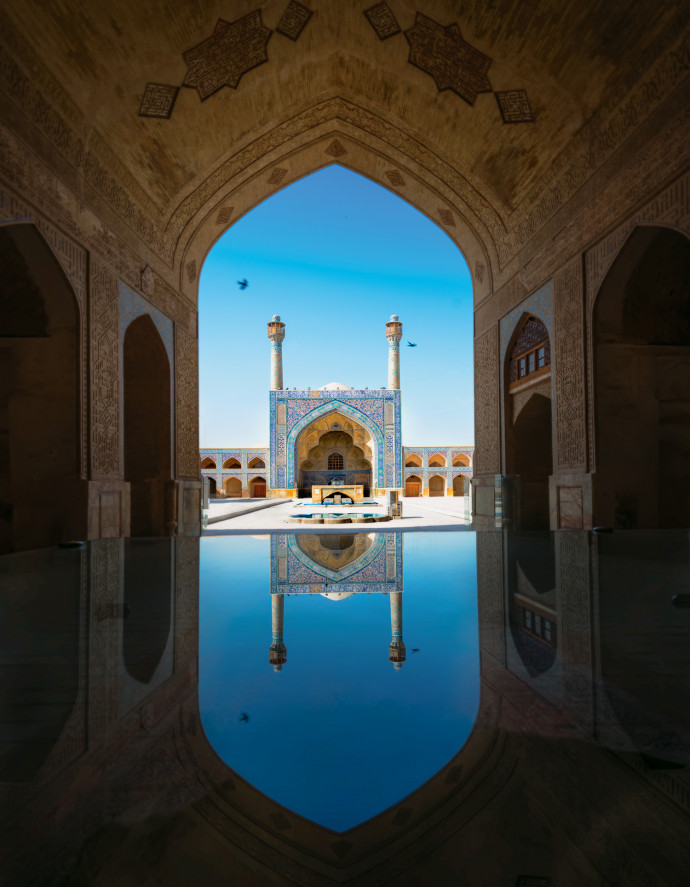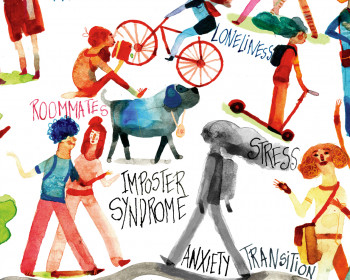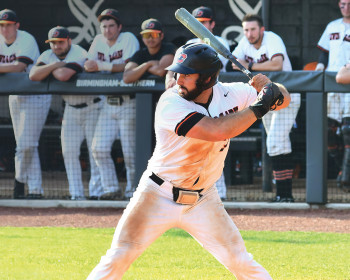An Iranian Revolution
Nearly 50 years ago, Lewis & Clark students embarked on a groundbreaking overseas study program to Iran. Last fall, they made a return visit.

On a spring morning in 1968, the golden rays of the rising sun illuminated the ruins of Persepolis, the ancient capital of the Persian Empire.
Sitting on its limestone steps, a group of nearly two dozen Lewis & Clark students listened with rapt attention to their history professor, Nosratollah Rassekh, read passages about Alexander the Great’s burning of the city in 330 BCE. The centuries seemed to drop away. “I think all of us remember that morning,” says Anne Laird BA ’69. “It was like living a historical moment.”
Nearly 50 years later, in fall 2016, Laird and five fellow alumni returned to Iran to revisit Persepolis and other locations from their overseas study program to Iran. On both occasions, their travels gave them a notable perspective on this complex country and its people.
“The political realm magnifies our differences into horrendous divides,” says Marilyn Lane BS ’68. “But if you don’t get caught up in that world, we are so similar in what’s important to us.”

Transnational empathy was one goal of former Lewis & Clark president Jack Howard when he launched the overseas study program in 1962. “His vision was to internationalize the campus,” says Nicole Schneider, assistant director of Overseas and Off-campus Programs. At the time, overseas programs were rare, overseas programs for undergraduates rarer still, and programs in non-Western countries like Japan and Mexico downright unheard-of.
“The political realm magnifies our differences into horrendous divides, but if you don’t get caught up in that world, we are so similar in what’s important to us.” Marilyn Lane BS ’68
“It was pretty revolutionary,” Schneider says. “It’s like the administration anticipated the globalized world that we’re living in today. They recognized the need to get outside of Western Europe and beyond cultures we’re more familiar with as Americans.”
Also uncommon was Lewis & Clark’s model of faculty-led programs—and it remains so today. Other colleges typically don’t have the institutional buy-in to release tenured faculty for a full semester to lead an overseas program, explains Schneider. But the faculty-leader model has significant benefits, one being that L&C professors return from abroad equipped with global perspectives they can integrate into their courses. “It internationalizes the curriculum,” Schneider says.
It was faculty member Nosratollah Rassekh, a popular history professor and native of Iran, who initiated the 1968 trip to his homeland. Making use of his fluent Farsi and family connections inside the country, Rassekh arranged for Lewis & Clark students to live and study for almost six months in Tehran, Iran’s capital. In those days, prior to the Islamic Revolution of 1979, Iran was a relatively secular, Western-oriented nation ruled by an autocratic monarch, Mohammad Reza Pahlavi, known as the Shah. At the time, many Americans could not have identified Iran on a map. But to the sort of students who had been drawn to Lewis & Clark by its nontraditional overseas study program, it sounded like an adventure.
“At the end of my freshman year, I was thinking I would go to Japan,” says Leslie Silvey BA ’70, a psychology major who had come to the college from the Bay Area. “But then they announced the program in Iran. Nobody ever traveled there … it wasn’t in the consciousness of most people at the time. It was just different.”

In January 1968, 23 Lewis & Clark students flew to Iran in what was then a marathon, globetrotting journey, with scheduled and unscheduled stops in Luxembourg, Germany, Turkey, and Lebanon. When they finally landed at the Tehran airport, they were met by what Silvey vividly describes as “a horde of Iranians waiting to pick up their American students.” Many of their hosts had their faces pressed up against a glass wall in the terminal. Exhausted and overwhelmed, the Lewis & Clark students were whisked off to their respective homestays, where they spent the next month.
Silvey recalls her first morning in Tehran—and her first moment of culture shock. One of the daughters in her host family, a young woman about her age, offered her pistachios from a bowl that had been placed in Silvey’s room. “She said, ‘Have you tried these? Foreigners usually like them.’ And I went, ‘Whoa, that’s me. I’m a foreigner!’” she laughs.
After the homestays, the men roomed in a dorm at the University of Tehran, and the women lived in other local housing. Together, they attended Rassekh’s classes on Iranian history and politics and studied Farsi. Each student also worked on an independent study project while in Iran. Rick Price ’72 centered his project on the bazaar as a social, cultural, and political institution. “I just found visiting the bazaar fascinating,” he says. “That’s where my Farsi really took off. I could practice it, and I could really experience the bazaar from the inside.”
When not in class, the group was often on the road, visiting Iran’s many cultural sites. However, in one instance, the group took what now seems like an unusual detour: they toured a nuclear research reactor in Tehran, north of the university. “At the time, we didn’t think anything of it,” says Bill Cummings BA ’69, JD ’78. “They put the radiation detectors on us, and away we went.” Cummings, like many of his classmates, tended to associate nuclear facilities with energy rather than weaponry in 1968.


The Iranian people themselves were warm and welcoming, but occasionally the group felt a different political undercurrent. “On one hand, it was a very hospitable country,” says Paul Barker BA ’71, MAT ’81. “But it was also the Shah’s Iran, so the secret police had a well-known presence behind the scenes.”
Two members of the Lewis & Clark contingent, Cummings and Jim Foster BA ’69, experienced a taste of this firsthand. On a beautiful day, while walking to class at the Iran-America Society, they decided to take some photos of Mount Damavand, a peak in the Alborz range that was only visible on a clear day. “Suddenly, a polite young man in an army uniform appeared and said, ‘No, no, no … you must come with me,’” recalls Cummings. The two L&C students didn’t realize they had inadvertently aimed their cameras at a political prison in the foreground. The guard escorted them to a police facility, where they ended up having to surrender their film. “Foster and I sort of got arrested until Professor Rassekh could get us sprung,” he says wryly.

While the Lewis & Clark students were out of the country, America, too, was becoming a more complicated place. After the Iran program ended, Silvey and a friend spent some time traveling abroad. They returned to the United States on June 5, 1968, the day Robert Kennedy was shot. This event came on the heels of the assassination of Martin Luther King Jr. and amid the Tet Offensive and surging anti–Vietnam War protests.
Back in Portland, even the Lewis & Clark campus had changed. Female students, for example, were no longer required to wear skirts and dresses to class. “We left campus one way, and when we came back, it was different,” says Silvey.
Of course, the students themselves had changed as well. Says Cummings, “I’ve never been quite the same. It was one of those great life-changing events.”
For some of the participants, the Iranian program influenced their future career direction. For Barker, the Iranian program served as a jumping-off point for a decades-long career in international humanitarian and development work. His work for organizations such as CARE and Save the Children took him to additional locations, including Afghanistan, Iraq, Palestine, Sudan, and Ethiopia, among other countries. “A lot of my perspective leads back to the Lewis & Clark experience,” he says.
Price says the Iranian program “impacted me the rest of my life.” He served as a study abroad advisor for several years at Colorado State University, seeking to replicate many aspects of the program he experienced at Lewis & Clark. Eventually, he started his own company, now called ExperiencePlus! Bicycle Tours, which offers bike tours in Europe, South America, Canada, and the United States.
The Iranian program inspired Lane, a senior English major at the time of the trip, to go into education. “I felt overwhelmed with this cultural experience that was so different from what I grew up with, yet every bit as solid and beautiful,” says the retired assistant superintendent. “Every chance I’ve had throughout my life, I’ve encouraged young people to experience other cultures.”

As the years passed, many of the Iran program alumni stayed connected to each other, reuniting every few years to reminisce and eat favorite Iranian dishes. Before he passed away in 2014, Rassekh, too, often attended these reunions.
It was around the time of Rassekh’s death that Lane began organizing in earnest something the group had idly talked about for years: a trip back to Iran. For her, the desire to return was tied to her memory of seeing the striking, blue-tiled Shah Mosque of Isfahan. “There are beautiful mosques all over Iran, but for some reason, this one really pulled me,” she says.
Lane enlisted the help of Barker, who had traveled back to Iran with a group of former Peace Corps volunteers in 2014. At that time, American tourists were allowed to travel in Iran only under the supervision of an Iranian guide, so he made arrangements with an Iranian tour company. Last September, after decades of dreaming and months of planning, a group of six program alums —plus spouses, family, and friends—touched down in Tehran.
“When we got off the plane, I was so excited,” Lane remembers. “I kept thinking, ‘We made it back.’ And every day, I felt so lucky to be there.”
Prior to the trip, Silvey had reconnected with one of the daughters from her homestay family. On one of the group’s first mornings in Tehran, the woman visited Silvey at their hotel, bearing gifts of sweets and pistachios. “I said, if the trip ends tomorrow, I’m happy,” Silvey recalls. “It tied ends together for me.”
Over the next two and a half weeks, the group traveled throughout the country, revisiting places they had been to in 1968 and discovering the many ways in which Iran had changed. Of course, the country’s laws have become starkly more religious since the revolution, with all women now required to cover their hair, arms, and legs in public. But the group was surprised to find that Iran had also become drastically more developed—complete with booming metropolises and a modern highway system.
“It’s an amazingly open country—it’s very friendly for foreign travelers and, if anything, pro-American in terms of people-to-people relations. They don’t like our government, but they seem to make a distinction between our government and our people.” Paul Barker BA ’71, MAT ’81
What had not changed, despite decades of political strife, was the country’s warmth and hospitality.
“In spite of all the suffering Iran has endured, it’s an amazingly open country—it’s very friendly for foreign travelers and, if anything, pro-American in terms of people-to-people relations,” says Barker. “They don’t like our government, but they seem to make a distinction between our government and our people.”

The Iran program alumni returned to the States in October. Not long afterward, the relationship between our government and that of the Iranians took a sharp turn downward. In January, President Donald Trump issued his executive order banning Iranians, along with citizens of some other majority-Muslim countries, from traveling to the United States; initially Iran retaliated by threatening to stop issuing visas for Americans (a threat which has not yet been implemented).
The group hopes future students will have the opportunity that they had through Lewis & Clark’s overseas study program 50 years ago: to traverse political and cultural borders, forming connections with ordinary people in the fascinating country of Iran.
“I feel strongly that we need to be in dialogue with Iran,” says Laird. “Iranians have been feeling on the outside—like America hates them—because that’s what they hear from their leadership. But in our interactions, there is an understanding that we are all connected.”
Comments from Bill Cummings BA ’69, JD ’78 and Rick Price ’72 were excerpted from interviews conducted for the Lewis & Clark Oral History Project.
More L&C Magazine Stories
Lewis & Clark Magazine is located in McAfee on the Undergraduate Campus.
MSC: 19
email magazine@lclark.edu
voice 503-768-7970
fax 503-768-7969
The L&C Magazine staff welcomes letters and emails from readers about topics covered in the magazine. Correspondence must include your name and location and may be edited.
Lewis & Clark Magazine
Lewis & Clark
615 S. Palatine Hill Road MSC 19
Portland OR 97219

